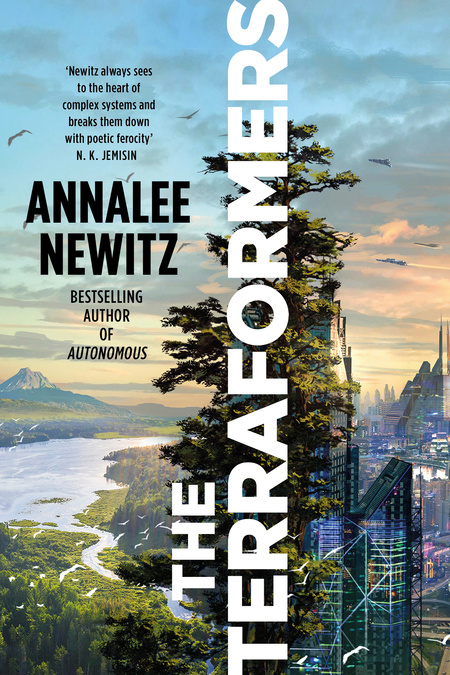One of the most exciting things about reading science fiction is its limitless capacity to take you to places that you never in a million years or multiverses encounter.
We live in a limited world, bounded by atmosphere and space, and circumscribed by culture, geography and a thousand other finite variables, but sci-fi busts all of that wide open, xenomorph bursting out of a chest style, and allows us to experience a host of ideas and people and thoughts and moments that will, if we let them, remake our mind in gloriously expansive ways.
Quite how special a thing this is is writ large in lavish detail in Annalee Newitz’s latest novel, The Terraformers – they delivered Autonomous previously, offering a similarly lifechanging view of a world far larger and more inclusive than our own – which takes us through hundreds upon hundreds of years on a planet called Sask-E, which almost 60,000 years after a societal revolution on Earth reshaped the relationship between humanity, animals and the environment as a whole, is being terraformed to be sold off to the filthy rich as their paradisiacal plaything.
The company behind the venture, Verdance, cares only for the bottom line, and while they have set aside conservation zones and have rangers from an ancient group known as the Environmental Rescue team on hand doing much of the business of changing Sask-E from barren to verdant, their main focus, and that of their ruthless CEO Ronnie Drake is to make as much as they can from the undertaking.
‘Think we’ll finally make it to the rainbow this time?’ Destry asked Nil. It was an old joke between them, from when they were new rangers chasing prismed light in the irrigation vapor plumes.
‘Well, you know how it is with rainbows,’ Nil replied. ‘Wherever you go, you’re never there.’
In the realm of The Terraformers, corporatism is king, and while humanity as a whole has configured itself into a League governed by the rule of law, corporations such as Verdance can do what they like in their fiefdoms, and often do.
This means that on Sask-E someone like Destry, who forms the beating heart of the novel’s first third or so, is effectively their property, decanted to a strict set of genomic criteria to perform certain tasks such as monitoring the health of a planet which eventually will be swarming with people and urban sprawl.
People in all kinds of Homo configurations from Neanderthal-like to Sapiens and to the infinite variety of Homo diversus (augmentation, biological and machine-driven, is everywhere) are nothing but tools for the greater corporate good, means to an end, which is making a planet pretty enough for people to buy into.
Beyond that – well, it will despoiled and ruined with all the many environmental sins of which humanity is unfortunately far too adept, but as long as it stays looking like paradise, specifically one from the Earth’s Pleistocene era, than all will be well.
For Verdance’s investors at least; for people like Destry and Misha and the many sentient creatures from drones to machines to moose and mole rats that make up the thrillingly complex category of “people” o the planet, life is grim and only going to get grimmer.
That is, until she discovers a whole race of people, all of them inclusively exciting in their variety, living in a volcano where no one should be, their carbon-neutral city hidden away from the world at large, and crucially from Verdance for whom even the smallest deviation from the corporate plan is unacceptable.
Her discovery changes everything and much of The Terraformers, which is as wondrous as ode to change and possibility as you will ever find in sci-fi, is spent dealing with the ramifications of her actions and how justice, though noble and idealistic, doesn’t always triumph over more grubby, greedy, utilitarian forces.
For all of its brutal honesty about the corporate way of things, and yes 60,000 years into the future, we haven’t evolved much beyond the stark crassness of modern society, The Terraformers also offers substantial hope about the way things can be.
With writing that is gently complex and wondrously rich with character and intelligent musing about the value of life and how it could come together in ways we have yet to conceive, Newitz puts forward a wholly enthralling idea that all people have value and worth and that that should never play second fiddle to bigotry and moneymaking.
Lest you dismiss this as fey wokeness, Newitz intelligently and empathetically sets forth a case for societies where everyone is emotionally and intellectually intelligent and grounds them in the reassuring idea that not everything is perfect and that mistakes are made all the time.
‘Where should we start?’ Misha addressed his question to Sulfur with a smile so pretty and unguarded that the Archaen had to look away. Maybe he was Verdance’s man, but there was also a shred of good in him.
Rich in deliriously good world-building imagination, and so involving that it is easy to lose yourself in a narrative that is both action-oriented and thoughtfully intimate, The Terraformers is groundedly prophetic, accepting that the rich and the powerful will likely keep trying to ensure the meek do not inherit one damn of the earth, or its planetary proxies.
However, it is also all too cognisant of the fact there is power in acceptance and inclusively and unconditional love and connection, and that far from being snowflake-y as many on the far right as wont to paint it, this kind of grounded idealism actually has real power and weight.
World-changing and destiny-altering weight in fact as evidenced by the story of Destry and those that follow her who stand David to Goliath against the fearsome forces arrayed around them, and sometimes within their own ranks (though thankfully this is rare) and emerge with a future so different from what is expected that it redefines Sask-E in its totality.
Their story is immensely enthralling and deeply affecting, peopled by sentient animals, machines and humans of all genomic stripes (literal and figurative), anchored by characters who are intensely likeable in their flawed but well-intentioned humanity, by epochs that are supposed to go one way until people decide to take a stand, and by a vigorously, expansively imaginative take on what the future holds, with The Terraformers all too aware terrible things can happen but so too good things when people take a stand for what is right and hopeful, and fight for a world which mirrors the best rather than the worst of what all life, wherever it comes from and however it looks and acts, is capable of and which it is eminently capable of living out if it just given a chance.

